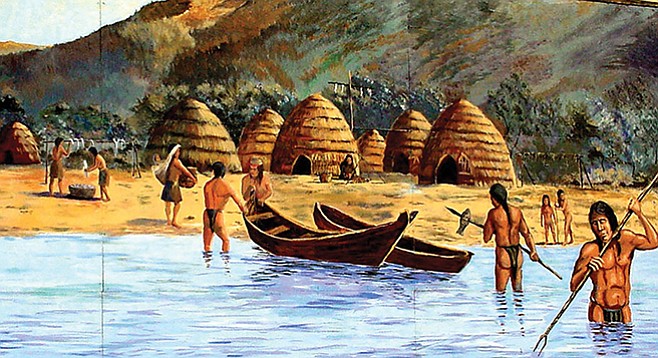 Facebook
Facebook
 X
X
 Instagram
Instagram
 TikTok
TikTok
 Youtube
Youtube

Among the endemic peoples in Southern California were the Mohavae, Yuma, Kamia, Diegueño, Miwok, and Chumash. These early settlers of the region had access to wild vegetables, fruits, and nuts. Wildlife was abundant, and they learned how to grow maize, beans, and squash. The Miwok and Chumash lived along the coast and had access to marine mammals, fish, clams, mussels, abalones, and crabs.
During the Late Formative period, beginning in 500 A.D., the Chumash incorporated the bow and arrow into their tools for survival; though, as coastal dwellers, the sewn-plank canoe, or tomol, became their greatest asset. These vessels (unlike the dugout canoe used in the north, where larger trees were available) were made of planks and joined with corded seal hide and sealed with tar. They were used in ocean-fishing, to travel back and forth between coastal towns, and were important in trade between the islands and the mainland.
The Chumash used a harpoon with a detachable fore-shaft for spearing large fish and marine mammals. They made fishhooks from shells for catching smaller fish, and they pounded fiber or used dried hide or intestines to make cord and netting.
The latter part of the Late Formative period is when the historically known California Indian cultures began to take their final form. Population rose rapidly, societies became intricate, warfare occasionally erupted over resources, and a common money system of shells and beads was standardized. The Indians developed nets for deep-sea fishing and formed cooperative labor crews and had craft specialists, including boat builders, captains, navigators, and boat owners.
Building fish dams and offshore net-fishing drew the labor of neighboring tribes, thus enhancing their shared technology.
The Ya’i Heki’ Regional Indian Museum at Lake Perris, north of San Diego in Moreno Valley, is one of a series of regional museums funded by the State of California. It provides an interpretation of Native American history and the cultures of the native tribes throughout the Southern California desert region. On December 12, the museum will be hosting Native American Fishing Techniques as a segment of their free weekly children’s program.


Among the endemic peoples in Southern California were the Mohavae, Yuma, Kamia, Diegueño, Miwok, and Chumash. These early settlers of the region had access to wild vegetables, fruits, and nuts. Wildlife was abundant, and they learned how to grow maize, beans, and squash. The Miwok and Chumash lived along the coast and had access to marine mammals, fish, clams, mussels, abalones, and crabs.
During the Late Formative period, beginning in 500 A.D., the Chumash incorporated the bow and arrow into their tools for survival; though, as coastal dwellers, the sewn-plank canoe, or tomol, became their greatest asset. These vessels (unlike the dugout canoe used in the north, where larger trees were available) were made of planks and joined with corded seal hide and sealed with tar. They were used in ocean-fishing, to travel back and forth between coastal towns, and were important in trade between the islands and the mainland.
The Chumash used a harpoon with a detachable fore-shaft for spearing large fish and marine mammals. They made fishhooks from shells for catching smaller fish, and they pounded fiber or used dried hide or intestines to make cord and netting.
The latter part of the Late Formative period is when the historically known California Indian cultures began to take their final form. Population rose rapidly, societies became intricate, warfare occasionally erupted over resources, and a common money system of shells and beads was standardized. The Indians developed nets for deep-sea fishing and formed cooperative labor crews and had craft specialists, including boat builders, captains, navigators, and boat owners.
Building fish dams and offshore net-fishing drew the labor of neighboring tribes, thus enhancing their shared technology.
The Ya’i Heki’ Regional Indian Museum at Lake Perris, north of San Diego in Moreno Valley, is one of a series of regional museums funded by the State of California. It provides an interpretation of Native American history and the cultures of the native tribes throughout the Southern California desert region. On December 12, the museum will be hosting Native American Fishing Techniques as a segment of their free weekly children’s program.
Comments